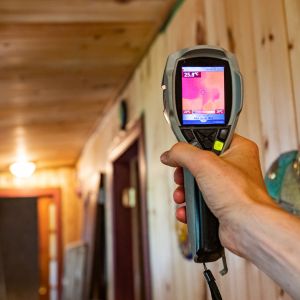Signs You Need a Mold Inspection and Air Quality Testing in Your Toronto Home
Posted in Mold, on March 27, 2024
Are there warning signs that you need a mold inspection in Toronto? When we asked the SafeAir team, the resounding answer was yes, followed by a caveat — the signs can be difficult to interpret because they are often subtle or mistaken for other issues in the home. Today’s blog will tell you more about how air quality testing can help you improve your home’s health and safety, as well as some of the most common warning signs that your home has a hidden mold infestation.
Air Quality and Your Health
 To begin, we'll tell you why you should have your air quality tested. Our modern way of life has us spending most of our time indoors, making outdoor pollution less of an issue than what’s happening inside our homes. Air quality can take a hit from many different areas: problems with airflow and ventilation can lead to allergen buildup, construction can release harmful substances like lead or asbestos, and environmental issues like floods or storm damage can lead to mold growth.
To begin, we'll tell you why you should have your air quality tested. Our modern way of life has us spending most of our time indoors, making outdoor pollution less of an issue than what’s happening inside our homes. Air quality can take a hit from many different areas: problems with airflow and ventilation can lead to allergen buildup, construction can release harmful substances like lead or asbestos, and environmental issues like floods or storm damage can lead to mold growth.
The air we breathe feeds our lungs, bodies, and brains, so ensuring it is clean and fresh has measurable results in many other areas of our lives. At SafeAir, we recommend homeowners have air quality testing performed to assess and measure their home’s air quality, especially if they have chronic health issues, elders, or children in the home.
Signs You Need Mold Testing and Inspection
Mold is a common air quality issue that affects many homes across Toronto and the GTA. It is a fungus that spreads by creating airborne “seeds” called spores. These spores are easily breathed in and can also settle on clothes, skin, and hair. Spores are the primary way that mold affects our health, though the mold itself can also damage your home by eating through wood, sheathing, and supports.
The common signs that you may have a hidden mold infestation include the following:
- A musty odour: The colony creates this as it grows and spreads. Many people say it reminds them of the forest or rotting wood.
- Sniffles and other flu-like symptoms: Mold’s initial effect on the human body causes symptoms reminiscent of the common cold or flu, like sneezing, sniffles, coughing and congestion. It’s particularly hard to tell the difference between pollen and mold exposure during allergy season! The main clue is that your symptoms disappear when you leave the house.
- Headaches: Some people experience sudden headaches around mold growth.
- Floods or water leaks: Even if you promptly cleaned up after a leaky pipe or flood, a short exposure to moisture is all that mold may need to grow.
- Stains or marks on walls or furniture: Mold may grow behind appliances, under flooring, or inside drywall, leaving marks that resemble stains on the outside.
Clean Up Your Air with SafeAir
Health starts from within but can significantly be affected by your environment. That's why we recommend mold inspection in Toronto for clients wishing to refresh their homes and enjoy healthy air. To learn more about air quality inspection or how mold affects your home, contact the SafeAir team today.

